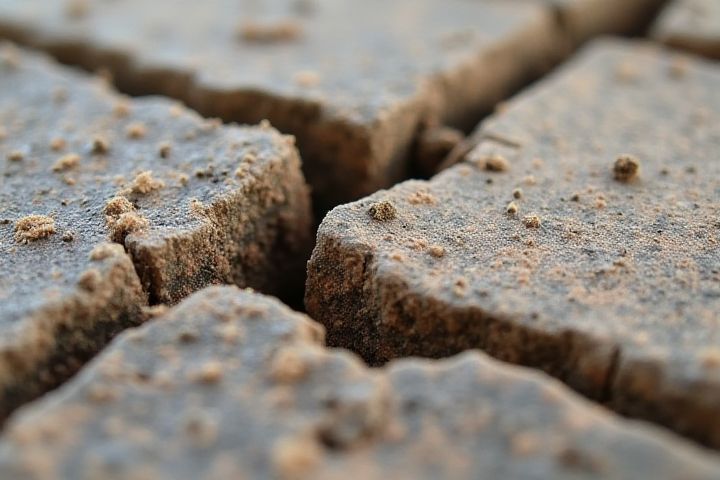
House foundations can crack due to various environmental and structural factors. Soil movement, often caused by changes in moisture levels, can lead to settling or heaving, resulting in cracks. Poor drainage around the home can exacerbate water accumulation, increasing the risk of foundation instability. Shrinkage of concrete as it cures can also contribute to hairline fissures, which may expand over time. It's essential to monitor foundation conditions regularly and address issues promptly to prevent further damage and maintain the structural integrity of your home.
When Does House Foundation Crack
Soil subsidence or settlement
House foundation cracks commonly occur due to soil subsidence or settlement, which can result from various factors such as moisture changes, soil type, and compaction. Approximately 60% of homes experience some form of foundation movement in their lifetime, often linked to clay-rich soils that expand when wet and shrink when dry. Ensuring proper drainage and landscaping can mitigate these issues by controlling water flow and reducing load on the foundation. If you notice cracks wider than 1/4 inch or horizontal shifts, it's crucial to consult a foundation expert for assessment and repair.
Tree root intrusion
House foundation cracks commonly occur due to tree root intrusion, especially when tree roots penetrate the soil beneath your foundation. As roots grow, they can exert significant pressure, leading to cracks that may widen over time--some may even reach a severity of 1 inch or more. Ideal distances suggest that trees should be planted at least 20 feet away from foundations to minimize damage. Regular monitoring and root management can help homeowners avoid costly repairs, as mitigating root intrusion can protect foundation integrity and structural safety.
Poor drainage or water pooling
Poor drainage around your home can lead to significant foundation cracks, often becoming evident during heavy rainfall or prolonged wet periods. When water pools around the foundation, hydrostatic pressure increases, potentially causing stress on the walls and base. A study indicates that nearly 40% of foundation issues stem from inadequate drainage systems, highlighting the importance of proper grading and downspout maintenance. Regular inspection and remediation of drainage problems can prevent costly repairs, ensuring the stability of your home's foundation.
Soil expansion and contraction
House foundation cracks often emerge due to soil expansion and contraction, which is primarily influenced by moisture content changes. During wet seasons, clay soils absorb water, causing them to swell and exert pressure on foundations. In contrast, during dry periods, these soils shrink, leading to gaps and resulting in structural stress. Monitoring soil conditions and incorporating proper drainage systems can mitigate the risk of foundation damage.
Inadequate foundational support
House foundation cracks often occur due to inadequate foundational support, which can stem from various factors such as poor soil quality, improper drainage, or insufficient concrete reinforcement. When the ground beneath your home shifts or settles unevenly, it creates stress on the foundation, leading to cracks that can compromise structural integrity. Soil types like clay are particularly prone to expansion and contraction with moisture changes, exacerbating the risk of foundation issues. Ensuring proper grading and drainage around your property is essential in preventing these costly damages and maintaining a stable foundation.
Extreme weather changes
House foundation cracks often emerge as a result of extreme weather changes, particularly during periods of drought or heavy rainfall. Prolonged dry spells cause soil shrinkage, which leads to settling, while excessive moisture can saturate the ground, increasing pressure on the foundation. Temperature fluctuations, especially in regions facing freeze-thaw cycles, can exacerbate this issue by causing expansion and contraction in the materials. Monitoring your foundation regularly can help mitigate damage caused by these environmental stressors, ensuring the structural integrity of your home.
Earthquake activity
House foundation cracks often occur during or after seismic activity due to the sudden ground shaking that can destabilize the soil around the foundation. The intensity and duration of an earthquake can lead to uneven settling, causing stress on the concrete or masonry materials and resulting in visible fractures. Furthermore, weak soil conditions, such as expansive clay or loose sand, heighten the risk of foundation damage during seismic events. It's crucial for homeowners in earthquake-prone areas to ensure proper foundation design and perform regular inspections to identify early signs of cracking.
Improper construction techniques
House foundation cracks often emerge due to improper construction techniques, such as inadequate soil preparation or insufficient drainage systems. When builders neglect to assess soil stability or fail to install proper grading, the resulting pressure can lead to uneven settling and structural stress. Incomplete reinforcement, such as lack of rebar or inadequate curing of concrete, can further compromise the integrity of the foundation. You should be aware that timely inspections and adherence to building codes can help mitigate these risks and ensure a stable foundation.
Low-quality materials
Low-quality materials in house foundations can lead to cracks developing within a few years of construction. Concrete with inadequate strength, as measured by a compressive strength of less than 2,500 psi, can deteriorate and expand under temperature fluctuations, resulting in fissures. Poorly mixed cement, which fails to achieve a water-cement ratio of 0.4 to 0.6, also increases the likelihood of cracking due to insufficient bonding and structural integrity. To ensure longevity and durability, always use high-quality materials and adhere to industry standards during foundation construction.
Heavy load changes or additions
House foundation cracks often occur when there are heavy load changes or additions to the structure. This issue typically arises when a new room or an additional floor is constructed, placing excess weight on the foundation. For example, a typical residential foundation is designed to support a load of approximately 40 pounds per square foot (psf), and exceeding this limit can lead to stress and subsequent cracking. Signs of potential issues include vertical cracks wider than 1/4 inch and horizontal cracks, which indicate significant structural pressure that should be addressed promptly for safety and stability.
